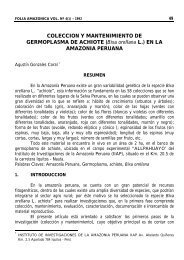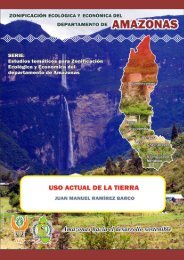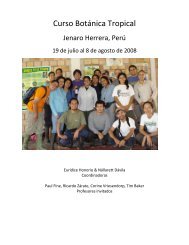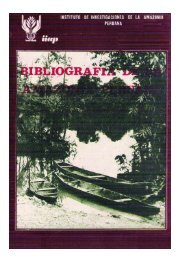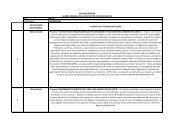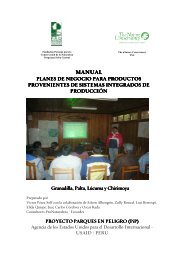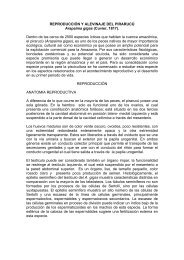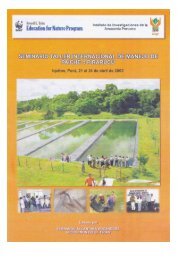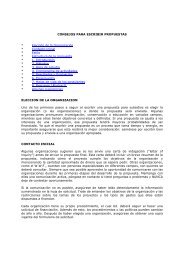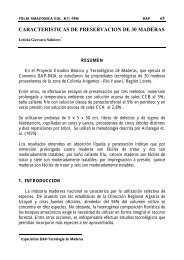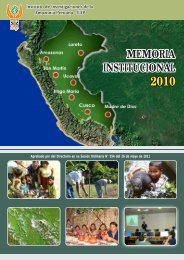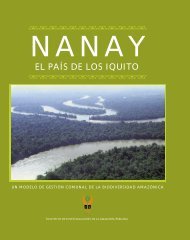versión preliminar - Instituto de Investigaciones de la Amazonía ...
versión preliminar - Instituto de Investigaciones de la Amazonía ...
versión preliminar - Instituto de Investigaciones de la Amazonía ...
Create successful ePaper yourself
Turn your PDF publications into a flip-book with our unique Google optimized e-Paper software.
62<br />
Programa <strong>de</strong> Investigación en Ecosistemas Terrestres (PET)<br />
Cuadro 1. Características <strong>de</strong> <strong>la</strong>s c<strong>la</strong>ses <strong>de</strong> aptitud biofísica para bo<strong>la</strong>ina b<strong>la</strong>nca<br />
SUELOS<br />
VARIABLES AMBIENTALES<br />
FISICO<br />
QUIMICO<br />
FISIOGRAFICO PAISAJE<br />
CLASES DE APTITUD PARA PLANTACIONES DE BOLAINA BLANCA<br />
Alta Media Baja<br />
Arcil<strong>la</strong> (%) > 74% 30 ‐ 65% < 30%<br />
Limo (%) 30 ‐ 50% 20 ‐ 40% < 20%<br />
Arena (%) 10 ‐ 20% 20 ‐ 40 % > 40%<br />
PH 6.3 ‐ 7.9 5.1 ‐ 6.2 < 5.0<br />
CIC (meq) > 20 15 ‐ 20 < 15<br />
PSB (%) > 80% 70 ‐ 80 < 70%<br />
Ca (meq) > 18 12 ‐ 18. < 12<br />
P.SAL (%) < 2 2 ‐ 8. > 8<br />
Drenaje<br />
Nivel <strong>de</strong> inundación<br />
Mo<strong>de</strong>rado Bueno a mo<strong>de</strong>rado Muy bueno<br />
(m) < 0.5 0.5 ‐ 1 > 1 m<br />
oril<strong>la</strong>res ‐ Tzas. Tzas. ondu<strong>la</strong>das ‐<br />
Fisiografia<br />
medias<br />
Lomadas > Colinas altas<br />
P<strong>la</strong>no ‐ Ligeramente Inclinaciones Fuertes Empinado<br />
Pendiente (%)<br />
incl. (0 ‐ 4)<br />
(15 ‐ 25)<br />
(> 25)<br />
Profundidad efectiva<br />
(cm)<br />
muy profunda<br />
(> 150)<br />
Mod. prof. ‐ profunda<br />
(50 ‐ 150)<br />
<strong>Instituto</strong> <strong>de</strong> <strong>Investigaciones</strong> <strong>de</strong> <strong>la</strong> <strong>Amazonía</strong> Peruana | Memoria 2008<br />
Superficial<br />
(< 50)<br />
Precipitación (mm) 3000 ‐ 4000 2000 ‐ 3000 < 2000<br />
Estos conocimientos permitirán <strong>la</strong> mejor p<strong>la</strong>nificación, el or<strong>de</strong>namiento territorial y el manejo<br />
sostenible <strong>de</strong> <strong>la</strong>s p<strong>la</strong>ntaciones forestales en Ucayali.<br />
SUB PROYECTO 5 : ALTERNATIVAS DE REFORESTACION EN SAN MARTIN Y AMAZONAS<br />
Alternativas <strong>de</strong> reforestación en San Martin y Amazonas<br />
Guillermo Vásquez<br />
Las intervenciones se re<strong>la</strong>cionan con el asesoramiento en manejo <strong>de</strong> viveros, i<strong>de</strong>ntificación <strong>de</strong><br />
zonas para reforestación, levantamiento <strong>de</strong> información sobre especies forestales promisorias<br />
para promover <strong>la</strong> reforestación en base <strong>de</strong> el<strong>la</strong>s, asi como <strong>la</strong> e<strong>la</strong>boración <strong>de</strong> nuevos proyectos <strong>de</strong><br />
investigación forestal en el marco <strong>de</strong> <strong>la</strong>s estrategias <strong>de</strong> <strong>de</strong>sarrollo regional y forestal <strong>de</strong> Amazonas<br />
y San Martin.<br />
Respecto a <strong>la</strong> i<strong>de</strong>ntificación <strong>de</strong> zonas para reforestación, se realizó mediante el monitoreo <strong>de</strong> <strong>la</strong><br />
<strong>de</strong>forestación acontecida en los últimos años sobre <strong>la</strong> base <strong>de</strong> <strong>la</strong> Zonificación Ecológica Económica<br />
en Amazonas y San Martin, <strong>la</strong> misma que <strong>de</strong>berá bajarse a nivel meso y microzonificación una vez<br />
concretado el interés por el órgano o institución correspondiente. Tal interés <strong>de</strong>be traducirse en<br />
<strong>la</strong> formu<strong>la</strong>ción <strong>de</strong>l presupuesto participativo y/o otros niveles <strong>de</strong> p<strong>la</strong>nificación. En tal sentido, se<br />
ha examinado el cuadro <strong>de</strong> <strong>la</strong>s zonas ecológicas y económicas <strong>de</strong> San Martin, entre <strong>la</strong>s cuales<br />
<strong>de</strong>stacan <strong>la</strong>s áreas para reforestación, presentadas <strong>de</strong> <strong>la</strong> siguiente manera: a) Zonas Productivas,<br />
que incluyen espacios para producción forestal y otras asociaciones, b) Zonas <strong>de</strong> Protección y<br />
Conservación Ecológica con sus zonas <strong>de</strong> protección (pendiente, suelos, humedales, cochas y<br />
asociados con producción forestal), y c) Zonas <strong>de</strong> Recuperación, referidas a zona <strong>de</strong> recuperación<br />
<strong>de</strong> tierras forestales, zona <strong>de</strong> recuperación <strong>de</strong> tierras forestales asociado con tierras <strong>de</strong> cultivos<br />
permanentes, y zona <strong>de</strong> recuperación cuenca <strong>de</strong>l Sauce; lo que hace aproximadamente un área



